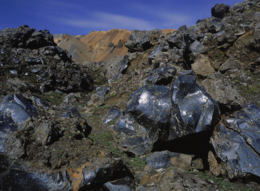- v50 information can now be added to pages in the main namespace. v0.47 information can still be found in the DF2014 namespace. See here for more details on the new versioning policy.
- Use this page to report any issues related to the migration.
Difference between revisions of "Igneous extrusive layer"
m (Unrating page for DF2014 (i: 9/45)) |
|||
| (17 intermediate revisions by 10 users not shown) | |||
| Line 1: | Line 1: | ||
| − | {{ | + | {{Quality|Superior}} |
| − | {{ | + | {{av}} |
| − | '''Igneous extrusive | + | [[File:igneous_extrusive_preview.png|thumb|260px|right|Created when magma exits a volcano and cools above the Earth's surface.]] |
| − | + | '''Igneous extrusive''' [[stone layers]] are formed from [[andesite]], [[basalt]], [[dacite]], [[obsidian]], and [[rhyolite]]. Of these five, andesite, dacite, and rhyolite are functionally identical, different only in appearance and name, basalt is like the other three except that it is magma-safe, and obsidian is... unique. | |
| − | |||
| − | |||
==Igneous extrusive layers== | ==Igneous extrusive layers== | ||
| Line 23: | Line 21: | ||
<small>* See also: [[stone found everywhere]]</small> | <small>* See also: [[stone found everywhere]]</small> | ||
| − | ==In | + | ==In Real Life== |
| − | In real world | + | In real-world geology, Igneous extrusive [[stone]] is formed by lava solidifying above the surface, open to the air. This is the main point of difference from [[igneous intrusive layer|igneous intrusive]] stone, which solidifies below the surface. This distinction is kept in ''Dwarf Fortress'' geology, with extrusive being the top layer around volcanoes and never the bottom-most layer, while intrusive is always the bottom layer and never the top. |
{{stones}} | {{stones}} | ||
{{Category|Stone Layers}} | {{Category|Stone Layers}} | ||
| + | [[ru:Igneous extrusive layer]] | ||
Latest revision as of 17:35, 7 May 2024
v52.04 · v0.47.05 This article is about the current version of DF.Note that some content may still need to be updated. |
Igneous extrusive stone layers are formed from andesite, basalt, dacite, obsidian, and rhyolite. Of these five, andesite, dacite, and rhyolite are functionally identical, different only in appearance and name, basalt is like the other three except that it is magma-safe, and obsidian is... unique.
Igneous extrusive layers[edit]
Stone found in igneous extrusive layers[edit]
- Hematite (veins)
- Native copper (veins)
- Galena (veins)
- Cinnabar (veins)
- Brimstone (small clusters)
- Realgar (small clusters)
- Orpiment (small clusters)
- Stibnite (small clusters)
- Magnetite (small clusters)
- Native aluminum (small clusters)
- Alunite (large clusters)
Stone appearing in both igneous intrusive and igneous extrusive layers[edit]
- Native gold (veins)
- Cobaltite (veins)
- Pyrolusite (small clusters)
- Hornblende (small clusters)
Gems found in igneous extrusive layers[edit]
- Turquoise (small clusters)
Gems appearing in both igneous intrusive and igneous extrusive layers[edit]
- Black zircon (small clusters)
- Green zircon (small clusters)
- Red zircon (small clusters)
- Brown zircon (small clusters)
- Yellow zircon (small clusters)
- Clear zircon (small clusters)
* See also: stone found everywhere
In Real Life[edit]
In real-world geology, Igneous extrusive stone is formed by lava solidifying above the surface, open to the air. This is the main point of difference from igneous intrusive stone, which solidifies below the surface. This distinction is kept in Dwarf Fortress geology, with extrusive being the top layer around volcanoes and never the bottom-most layer, while intrusive is always the bottom layer and never the top.
| Sedimentary | |||||
|---|---|---|---|---|---|
| Igneous |
| ||||
| Metamorphic | |||||
| Ore | |||||
| Economic | |||||
| Other |
Alunite · Anhydrite · Bauxite · Borax · Brimstone · Chromite · Cinnabar · Cobaltite · Cryolite · Graphite · Hornblende · Ilmenite · Jet · Kimberlite · Marcasite · Mica · Microcline · Olivine · Orpiment · Orthoclase · Periclase · Petrified wood · Pitchblende · Puddingstone · Pyrolusite · Realgar · Rutile · Saltpeter · Serpentine · Slade · Stibnite · Sylvite · Talc | ||||
